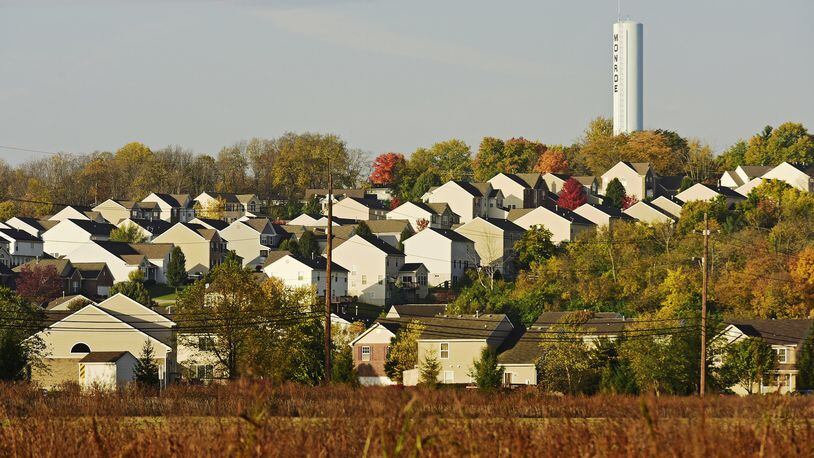MORE: Ohio continues anemic population growth
Monroe saw the largest overall growth between 2010 and 2016 with just more than 0.08 percent as it grew from 12,442 to 13,473 or an increase of 1,031 residents since the 2010 Census.
“We’re always excited to welcome new residents to Monroe,” said Jennifer Patterson, assistant to the city manager for economic development. “While a lot of the growth is likely attributable to the number of available lots for new home construction and existing housing inventory that is in high demand, many of the residents also see value in our great school system and easy access to employment opportunities within the region as well.”
Monroe was followed by Trenton whose population increased since the last census from 11,869 residents to 12,612 residents, an increase of 893 residents or by just more than 0.07 percent.
“I think it starts with a few things such as a having a good school system, a good business base and affordable housing,” said Trenton City Manager John Jones. “We also are finding people who want to build here because we have land available. Having the availability of land is a chance to expand our city and increase our population.”
Jones said the city’s location and proximity to Cincinnati and Dayton helps make Trenton an attractive place to live as well as being a safe community.
While there has a been an increase in population, Jones said the Trenton has been slower than other communities to see its economy pick up.
While he has not analyzed the census data yet, Jung-Han Chen, Oxford’s community development director, thinks Miami University may be a reason for the population growth.
“Miami’s enrollment has increased steadily the past few years and some faculty may be choosing to live here,” he said.
Middletown Mayor Larry Mulligan said the recent population increase in the city is showing that local officials are working on some of the right things such as affordable housing and revitalizing its downtown with new businesses.
“Urban environments appeal to Millenials according to studies and we have a lot to offer,” Mulligan said. “I take it as an encouraging sign.”
According to the 2016 population estimate, Middletown is at 48,813, which is up 119 residents since the 2010 census.
“As we work through our housing issues, I think we’ll see continued positive growth,” Mulligan said. “I think we have a lot to offer first-time home buyers and for people starting out.”
Mulligan said he’s seeing an uptick in the economy as more employment opportunities are becoming available.
Other cities showing modest increases since the 2010 Census were Fairfield, Oxford, New Miami, Seven Mile, Millville, College Corner, and Somerville.
Hamilton was the only Butler County city to show a decrease in population since the last census. Its 2016 estimated population is 62,127, which is down from 62,477 or about 350 people, a change of -0.005 percent.
“I don’t see that being a material change in population,” said Joshua Smith, Hamilton’s city manager. “Growing our population is not a strategic priority, but improving property values is. I do not see our population climbing or dropping in any significant fashion when the next true census is done in 2020.”
The village of Jacksonburg showed no change as its population remains at 63, which was the population when the 2010 Census was taken.
The next decennial census will be done in 2020.
Overall, Ohio cities didn’t fare well in terms of growth in 2016.
Columbus, which surpassed Indianapolis as the 14th most populous city, was the highest ranked for growth in the state at 251st in the U.S. Ohio’s capital city grew by 10,000 people to 860,090 — a 1.2 percent change.
Columbus is now the second largest city in the Midwest behind Chicago, which had an estimated population of 2.7 million, down slightly from the last estimate.
Cincinnati’s population growth was listed as zero percent. The city gained just fewer than 150 people. It’s population on July 1, 2016 was estimated at 298,800.
Cleveland’s population declined by .5 percent to 385,809.
RELATED: Warren County is the 3rd fastest growing area in Ohio; Dayton metro area up, too
Medium-sized cities including Dayton, Toledo, Akron, and Canton all saw declines in population.
Staff Writer Katie Wedell contributed to this report.
BUTLER COUNTY 2016 POPULATION ESTIMATES
Hamilton: 62,477
Middletown: 48,694
Fairfield: 42,250
Oxford: 21,371
Monroe: 12,442
Trenton: 11,869
New Miami: 2,249
Seven Mile: 751
Millville: 708
College Corner: 407
Somerville: 281
Jacksonburg: 63
Source: U.S. Census Bureau
About the Author
